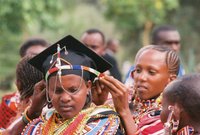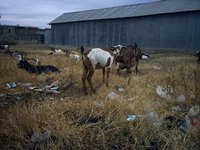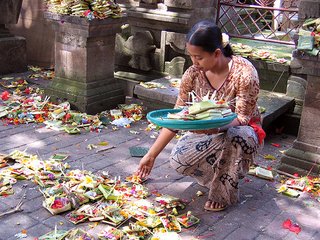:::::::::::::::::::::::::::::::::::::::::::::::::::::::::::::::::::::::::::::::::::::::::::::::::::::
Jamhuri Day
(Republic Day -- Independence Day)
***** Location: Kenya
***** Season: Hot dry season, 12 December
***** Category: Observance
*****************************
Explanation
HISTORY: UHURU, JAMHURI, HARAMBEE (1963-1978)
The 12th of December, 1963, was the day of the declaration of independence (Uhuru), and just one year later a new country was born: the Republic of Kenya, Jamhuri ya Kenya, presided by Mzee Jomo Kenyatta. He based his mandate, until his death in 1978, in something that would become a motto for the people of Kenya: Harambee, meaning "pulling all together at once".
With independence, many Europeans left the country, fearing that the free Kenya would give rise to new times of prosecution and extermination of the representatives of the old European power. In fact, the former Mau-Maus were waiting for the green light to invade the whites' farms. Very differently, those that chose to stay found a conciliatory and dialoguing Kenyatta, pragmatic and intelligent, inviting the Europeans to join Harambee and not excluding anyone of the national construction process. Some of the former Colony's chief civil servants kept their jobs. Kenyatta requested the Bristish troops in Kenya to remain and help him extinguish the Somalis revolts in the North East and an army mutiny in Nairobi. This presence would be expanded through a defense agreement between Kenya and Great Britain, that kept the British army in their current headquarters in Nanyuki.
http://www.kenyalogy.com/eng/info/histo14.html
xxxxxxxxxxxxxxxxxxxxxxxxxxxxx

More Kenya history :
http://kenya.com/history.html
xxxxxxxxxxxxxxxxxxxxxxxxxxxxx
Kibaki to address Jamhuri fete climax
By DAVID MUGONYI
(12 December 2003)
The 12-day festivities to mark Kenya's 40th independence anniversary will end today with fanfare and President Kibaki's address to the nation. The Head of State will preside over his first Jamhuri Day celebrations at Nyayo National Stadium.
Nairobi Provincial Commissioner Francis Sigei announced that a number of traditional dancers and choirs had been lined up to entertain guests at the stadium. In addition, a children display drill by Nairobi primary schools, trooping of the colour by 20 para-battalion and a fly past by Kenya Air Force Jets will feature.
Later in the afternoon, the President will host a Garden Party at State House.
Other festivities lined up include a football match between Coast Stars and AFC Leopards, netball at Railway Club and hockey at City Park. Mr Sigei said this year's celebrations were special because they marked a reflection on what has taken place in Kenya since 1963.
Some freedom fighters are expected to grace the occasion and are likely to be among those invited to the State House party. Several World leaders among them US President George Bush and Her majesty Queen Elizabeth of England sent congratulatory messages to President Kibaki.
Also congratulating the President was the Aga Khan Development Network.
President Bush said: "The elections of December 2002 and the strong tide of civic spirit that was evident then have made this year's national day one of special hope."
"The democratic transition that has occurred since Kenya's last national day has set an example for others and opened great opportunities both for Kenyans and for Kenya's relationships with its friends abroad," he added.
Cuban President Fidel Castro said: "I will avail myself to this significant anniversary to reiterate our resolve to continue doing our best to strengthen and expand the relations of friendship and cooperation between Cuba and Kenya."
Other messages came from leaders of Israel, Austria, China, Japan, several African countries and Kenya's high commissioners and ambassadors.
The would be Sh100 million 12-day festivities saw ministers and government officials conduct build up activities such as opening bridges, roads, exhibitions, taking part in clean-ups, prayers and anti-Aids campaign.
New coins of Sh40 went into circulation yesterday together with two commemorative ones – a gold one with a face value of Sh5,000 and a silver one valued at Sh1,000 – both of which bear President Kibaki's portrait.
With the three coins came a new Sh200 note bearing President Kenyatta's image.
Meanwhile, the Kenya Wildlife Service has announced reduced entry fees for Kenyans visiting the Nairobi Animal orphanage and Safari Walk today. Adults will pay Sh40 instead of Sh80 at the orphanage while children will pay Sh10. The Safari walk will attract Sh50 for adults and Sh20 for children.
http://www.nationaudio.com/News/DailyNation/12122003/News/News1212200343.html
xxxxxxxxxxxxxxxxxxxxxxxxxxxxx
Veteran politician Achieng' Oneko chats with Mrs Mukami Kimathi right), widow of his fellow freedom fighter Dedan Kimathi, after they both attended yesterday's Jamhuri Day celebrations at Nyayo National Stadium. With them is Mrs Nyambura Kariuki, widow of politician J. M. Kariuki. photo by:Joseph Mathenge (Daily Nation 13.12.2004)
source : www.nationmedia.com/dailynation/nmgindex.asp
xxxxxxxxxxxxxxxxxxxxxxxxxxxxx
The original Jamhuri Day was a happy occasion, with Lord Mountbatten representing the United Kingdom and Jomo Kenyatta representing Kenya. As the British flag was gradually lowered, Lord Mountbatten turned to Jomo Kenyatta and joked: "You can still change your mind!" -- an offer laughingly turned down.
Nowadays, most Kenyans spend Jamhuri Day either by attending public festivities in Nyayo Stadium or local stadiums in their towns (very entertaining, as described in the article above) or watching them live on television. The biggest moment is when the President rises to speak -- first in Swahili, then in English, and all listen to his political comments and priorities.
More light-hearted are the parades (including military, other uniformed forces, and also civic staff such as the Nairobi City Council road sweepers), each accompanied by their own bands and choirs, some of them semi-professional. A great highlight is the Kenya Airforce fly-past, the pilots highly skilled in aerobatics which I have rarely seen anywhere else. They take off in Nanyuki Airforce Base, some 200 km from Nairobi, and arrive with perfect timing and synchronisation to delight the crowds before sweeping around in a loop and heading back beyond Mount Kenya.
On public holidays, most shops are shut, and the newspapers publish special editions with historical articles and photographic memorabilia. These days are very much enjoyed by the public.
Jamhuri Day, happening as it does on 12 December, becomes the start of the Christmas season. Many Nairobians, who travel up-country to celebrate the feast with their rural families (goat meat being the preferred festive fare), stay there until after the New Year holiday.
Isabelle Prondzynski
xxxxxxxxxxxxxxxxxxxxxxxxxxxxx
LIFESTYLE MAGAZINE
On Melody Makers - Jamhuri Day treat of fun and revelry
Story by Amos Ngaira
Publication Date: 12/12/2004
Since it's Jamhuri Day today, revellers have an extended holiday tomorrow, which club owners and hoteliers will be keen to cash into.
In Nairobi, the highlights include a special Jamhuri Day performance this afternoon by veteran musician Aziz Abdi and his Orch Ngoma Afrika Band at the Jam Rescue Club on Jogoo Road. Aziz has lined up the best of his wide repertoire, including his latest song, Utamu wa Samaki, and old hit songs such as Nyumbani ni Nyumbani and Kina Kazi.
Members of his band include former Les Wanyika singer Rama Kocha and solo guitarist Malady. This afternoon, various traditional dance troupes will also perform.
For Benga fans, songbird Princess Jully and her Jolly Boys Band will this afternoon entertain at the Itua Gacwiri Gardens at Uthiru. She is riding high with tracks from her latest CD Resa.
The Weavers Band of James Limeri will entertain at the Pizza Garden at Landmark Hotel at Westlands. The group specialises in Lingala, Kiswahili, pop and Benga tunes.
Klub House II will tonight host a Soul party, and the Carnivore Restaurant, a Jamhuri Soul Nite in the Simba Saloon. At Kawangware, Mazembe Academia Band of ace guitarist Loboko Pasi will play new and old Lingala songs at Bora Bora Hotel.
Traditional dance and comedy shows
Nyeri: The famous Outspan Hotel will host shows by the Mt Kenya Mwomboko group, and comedy by the Gorillaman group on Jamhuri Day. The very young will this afternoon enjoy bouncing castles, horse rides, and face painting, with cool soothing music by the poolside. At the Impala Club, also in Nyeri, DJ Mike will host a Jamhuri jam session featuring the best of Blues, R&B and reggae. At Green Hills Hotel, DJs Mike and Jarovia will keep fans on their feet.
A concert dubbed the 'Great Eastern Bambika Party' will be held today at Hotel Milimani's Club Dimples. Rapper Lyrical Erico, of the Bambika hit song fame, will perform.
In Nairobi, Kenya's top record labels, music distributors, and entertainment firms are taking part in a four-day music exhibition, "Kenya Music Week" at the Expo Hall, Sarit Centre, which ends today.
Top band on tour of western Kenya
Kitale: The Everest Kings Band of Abdul Muyonga and Freshely Mwamburi will perform at a Jamhuri Day Special dance tonight at the Modern Club at Moi's Bridge.
The return of Mwamburi, composer of the hit song, Stella, has added life to the band. He had quit the band to join the Great Sound Band based at Athi River. Next week, they will perform at Makuti Club in Bungoma, and Mumias.
I Nakuru, Club Dimples will host a Jamhuri Day disco show, with DJs Mdosi and Double J.
The western Kenya nominations for the first annual national music talent search will be held on Friday at the Golf Hotel in Kakamega. The event was to be launched at Tsavorite Hotel, Voi last night. It has been sponsored by Soul Sounds, 4 Play Records (Majimaji Productions), Kidrays Street Productions (Nairobi), Sound Check Studio (Kisumu) and Stone ProductionsÝ
Acording to DJ Stone, the Kisumu nominations will be held on Saturday at the Beach Resort Club.
Compiled by Amos Ngaira
http://www.nationmedia.com/dailynation/nmgcontententry.asp?category_id=33&newsid=21618

*****************************
Worldwide use
*****************************
Things found on the way
Tanzania is also a "Jamhuri" (republic), but does not have a Jamhuri Day. Instead, it celebrates the union of Tanganyika and Zanzibar (1964) on 26 April each year (Union Day / National Day).
Kenya music and dance is described on this page :
http://kenya.com/music.html
*****************************
HAIKU
Watching the fly-past --
cool drinks in the garden --
Jamhuri Day.
Jamhuri Day --
we can still change our minds --
Christmas in London?
Isabelle Prondzynski 2004
:::::::::::::::::::::::::::::::::::::::::::::::::::::::::::::::::::::::::::::::::::::::::::::::::::::::::::::::::
Jamhuri Day --
not so sweet for the Mau Mau,
many dead and gone.
Isabelle Prondzynski 2004
:::::::::::::::::::::::::::::::::::::::::::::::::::::::::::::::::::::::::::::::::::::::::::::::::::::
Haiku collection
. Jamhuri Day 2011 .
. Jamhuri Day - Andrew Otinga .
*****************************
Related words
***** Madaraka Day Kenya
***** Independence Day (worldwide at different seasons)
[ . BACK to WORLDKIGO . TOP . ]
:::::::::::::::::::::::::::::::::::::::::::::::::::::::::::::::::::::::::::::::::::::::::::::::::::::



























